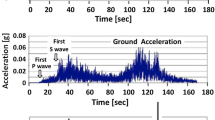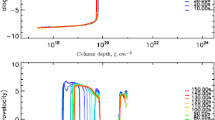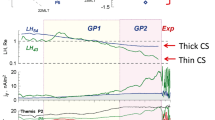Abstract
Unipolar pulses (UPs) are short events characterized by outbursts of electromagnetic (EM) energy from deep within the Earth's crust. First recognized prior to the 2007 M = 5.4 Alum Rock earthquake in northern California, UPs can be as short as 150ms, followed by an overshoot in the opposite polarity direction or by undulations of the EM field lasting from to 2−20 sec. Near Lima, Peru, and Tacna, Peru, thousands of UPs in the 1−3 nT intensity range have been recorded, emitted from the 25−65km depth range, thought to arise in patches at the top of the Benioff Zone of the subducting Nazca Plate. To understand how these EM pulses can be generated deep in the rock column, we consider that rocks contain peroxy defects, typically O3Si−OO−SiO3, which, when subjected to increasing deviatoric stresses, break up in two steps. Step I: electrons in the tight non-bonding πnb molecular orbital decouple by transitioning into the antibonding σ*-level, where they occupy a significantly larger volume. This volume expansion is possible only, when the internal pressure in the stressed subvolume overcomes its confining pressure. This in turn requires that the number density of peroxy defects in the rock is high enough so that, during the πnb → σ* transition of the O−−O− bonds, the wave function of their decoupled O− states overlap, causing a solid plasma state with an internal electron degeneration pressure that can force the volume expansion against the load of the overlying rock column. Step II: once the σ*-level is reached, the decoupled O−−O− bonds can dissociate, generating highly mobile charge carriers, electrons e' and holes h•, which can burst out the stressed subvolume causing it to instantly contract again. Thus, UPs appear to be linked to an explosive expansion of stressed subvolumes of rocks against their lithostatic overload, followed by an outburst of electronic charge carriers and concomitant volume contraction.
Similar content being viewed by others
References
M.T. Torabi, M. Fattahi, Iran. J. Geophys. 2019, 50 (2019).
N.E. Whitehead, Ü. Ulusoy, Earth Sci. Res. J. 19, 113 (2015).
C. Fidani, Nat. Hazards Earth Syst. Sci. 10, 967 (2010).
T.V. Losseva, I.V. Nemchinov, Nat. Hazards Earth Syst. Sci. 5, 649 (2005).
M. Kamogawa, H. Ofuruton, Y.-H. Ohtsuki, Atmos. Res. 76, 438 (2005).
J.S. Derr, Bull. Seismol. Soc. Amer. 63, 2177 (1973).
P. Hedervari, Z. Noszticzius, Ann. Geophys. 3, 705 (1985).
F.T. Freund, Pure Appl. Geophys. 176, 3439 (2019).
C.-Y. King, Nature 301, 377 (1983).
T. Bleier, et al., Nat. Hazards Earth Syst. Sci. 9, 585 (2009).
P. Nenovski, Acta Geod. Geophys. 53, 555 (2018).
L.J. Lanzarotti, Telluric currents: The natural environment and interactionw with man-made systems, in The Earth’s Electrical Environment, edited by N.R.C.G.S Committee (National Academies Press, 1986), pp. 232–258.
R. Shida, Trans. Seismol. Soc. Japan 9, 32 (1886).
M. Becken, P.A.B. Oliver Ritter, U. Weckmann, Nature 480, 87 (2011).
K.N. Kappler, et al., Comput. Geosci. 133, 104317 (2019).
D. Helman, Ann. Geophys. 56, G0564 (2013).
F. Zencher, M. Bonafede, R. Stefansson, Geophys. J. Int. 166, 1318 (2006).
P.W.J. Glover, Treat. Geophysics 11, 89 (2015).
A. Revil, J. Colloid Interface Sci. 307, 254 (2007).
L. Valoroso, L. Chiaraluce, C. Collettini, Geology 42, 343 (2014).
D. Zhao, O.P. Mishra, R. Sanda, Phys. Earth Planet. Inter. 132, 249 (2002).
D. Alekseev, A. Kuvshinov, N. Palshin, Earth Planet. Space 67, 108 (2015).
E.I. Parkhomenko, A.T. Bondarenko, Electrical conductivity of rocks at high pressures and temperatures (NASA, Moscow, 1972), p. 212.
J. Scoville, J. Sornette, F.T. Freund, J. Asian Earth Sci. 114, Part 2 (2015) 338.
C.H. Scholz, in The mechanism of earthquakes and faulting, 2nd ed. (Cambridge Univ. Press, Cambridge, UK, 2002), p. 470.
G. Hayes, T. Crone, At what depth do earthquakes occur? What is the significance of the depth? (2018).
J. Kious, R.I. Tilling, This dynamic earth: the story of plate tectonics, USGS Unnumbered Series (1996).
T.E. Battalino, B. Vonnegut, J. Appl. Meteorol. 17, 1225 (1978).
A.V. Guglielmi, Izvestiya Phys. Solid Earth 42, 179 (2006).
J. Bortnik, et al., Ann. Geophys. 28, 1615 (2010).
K.-J. Kim, et al., arXiv:physics/0003064v2 (2000).
J.C. Dunson, S.R.T.E. Bleier, J. Heraud, C.H. Alvarez, A. Lira, Nat. Hazards Earth Syst. Sci. 11, 1 (2011).
J.A. Heraud, et al., Determining Future Epicenters by Triangulations of Magnetometer Pulses in Peru, in AGU Fall Meeting (AGU, San Francisco, CA, 2013).
J.A. Heraud, V.A. Centa, Triangulation of Pulses of Electromagnetic Activity to Determine When and Where Earthquakes will occur in Central Peru, in 4th Bi-Annual International Geo-Hazards Research Symposium (IGRS, NASA Ames Research Park, 2014).
P. Nenovski, C.R. Acad. Sci. 69, 775 (2016).
E.I. Parkhomenko, Rev. Geophys. Space Phys. 20, 193 (1982).
F.T. Freund, M.M. Freund, J. Asian Earth Sci. 2015, 373 (2015).
F. Freund, M.M. Freund, F. Batllo, J. Geophys. Res. 98, 22209 (1993).
R. Martens, H. Gentsch, F. Freund, J. Catal. 44, 366 (1976).
F. Freund, H. Wengeler, J. Phys. Chem. Solids 43, 129 (1982).
F. Freund, H. Wengeler, R. Martens, Geochim. Cosmochim. Acta 46, 1821 (1982).
G.R. Rossman, Phys. Chem. Miner. 23, 299 (1996).
M.M. Abraham, C.T. Butler, Y. Chen, J. Chem. Phys. 55, 3752 (1971).
A.H. Edwards, W.B. Fowler, Phys. Rev. B 26, 6649 (1982).
E.J. Friebele, et al., Phys. Rev. Lett. 42, 1346 (1979).
D. Ricci, et al., Phys. Rev. B 64, 224104 1 (2001).
P.E. Kazin, et al., ChemInform 43, 32 (2012).
F. Freund, M.M. Masuda, J. Mater. Res. 6, 1619 (1991).
F.A. Kröger, The chemistry of imperfect crystals, North-Holland Publisher, Amsterdam, 1964.
O.E. Taurian, M. Springborg, N.E. Christensen, Solid State Commun. 55, 351 (1985).
H. Kathrein, F. Freund, J. Phys. Chem. Solids 44, 177 (1983).
H. Wengeler, F. Freund, Mater. Res. Bull. 15, 1241 (1980).
F. Batllo, et al., J. Appl. Phys. 67, 5844 (1990).
F. Batllo, et al., J. Appl. Phys. 69, 6031 (1991).
F. Freund, E.J. Whang, J. Lee, Highly mobile hole charge carriers, in: F. Fujimori, M. Hayakawa (Eds.), minerals: Key to the enigmatic electrical earthquake phenomena?, in Electromagnetic Phenomena Related to Earthquake Prediction, Terra Sci. Publ. Co., Tokyo, 1994, pp. 271–292.
N. Munjal, et al., J. Phys.: Conf. Ser. 377, 012067 (2012).
A.K. Jonscher, in Dielectric relaxation in solids , Chelsea Dielectrics Press, London, 1983, p. 380.
C. Kittel, Introduction to solid state physics. 7th ed. (Wiley, New York, 1996).
D. Balzar, J. Res. Nat. Inst. Stand. Technol. 98, 321 (1993).
P.K. Abraitis, R.A.D. Pattrick, D.J. Vaughan, Int. J. Mineral Proc. 74, 41 (2004).
G. Pacchioni, et al., Phys. Rev. B. 48, 11573 (1993).
C.Y. Ho, R.E. Taylor, Thermal Expansion of Solids, ASM International, Materials Park, OH, 1998.
B. Henderson, J.E. Wertz, Defects in the Alkaline Earth Oxides (Taylor & Francis, London, 1977).
D.L. Griscom, Glass Sci. Technol. 4B, 151 (1990).
E.-H. Chen, T.-C. Chang, J. Molec. Struct. Theochem. 431, 127 (1998).
D. Ricci, et al., Phys. Rev. B 64, 224104–1 (2001).
F.T. Freund, Nat. Hazards Earth Syst. Sci. 7, 1 (2007).
A.P. Boresi, R.J. Schmidt, O.R. Sidebottom, Advanced Mechanics of Materials (Wiley, 1993).
H. Kimizuka, et al., Phys. Rev. B 75, 054 (2007).
J. Scoville, J. Heraud, F. Freund, Nat. Hazards Earth Syst. Sci. Discuss. 2, 7367 (2014).
J.A. Heraud, V. Centa, T. Bleier, Electromagnetic Precursors Leading to Triangulation of Future Earthquakes and Imaging of the Subduction Zone, in AGU Fall Meeting (AGU, San Franciso, CA, 2015).
F. Freund, J. Geodyn. 33, 545 (2002).
D.L. Griscom, Glass Sci. Technol. 48, 151 (1990).
G.K. Schenter, R.L. Liboff, J. Appl. Phys. 62, 177 (1987).
F.J. Dyson, A. Lenard, J. Math. Phys. 8, 423 (1967).
T. Toulkeridis, et al., J. Geodyn. 126 (2019).
C.A. Balanis, in Advanced engineering electromagnetics (Wiley, 2012), p. 1040.
J. Scoville, J. Heraud, F. Freund, arXiv:1405.4482 (2014).
C.G. Dodd, G.L. Glen, J. Appl. Phys. 39, 5377 (1968).
G. Frenking, S. Shaik, in The Chemical Bond. Fundamental Aspects of Chemical Bonding (John Wiley, 2014), p. 438.
T.V. McEvilly, W.A. Peppin, Geophys. J. Int. 31, 67 (1972).
USGS, Earthquake Booms, Seneca Guns, and Other Sounds (2018), Available from: https://www.usgs.gov/natural-hazards/earthquake-hazards/science/earthquake-booms-seneca-guns-and-other-sounds?qt-science_center_objects=0#qt-science_center_objects.
Author information
Authors and Affiliations
Corresponding author
Additional information
Publisher’s Note
The EPJ Publishers remain neutral with regard to jurisdictional claims in published maps and institutional affiliations.
Rights and permissions
About this article
Cite this article
Freund, F.T., Heraud, J.A., Centa, V.A. et al. Mechanism of unipolar electromagnetic pulses emitted from the hypocenters of impending earthquakes. Eur. Phys. J. Spec. Top. 230, 47–65 (2021). https://doi.org/10.1140/epjst/e2020-000244-4
Received:
Accepted:
Published:
Issue Date:
DOI: https://doi.org/10.1140/epjst/e2020-000244-4




